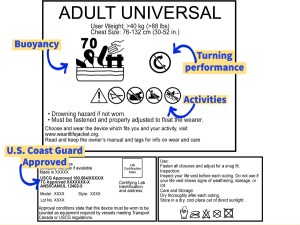How to Safely Use a Life Jacket
Life Jackets are designed to keep you safe. These personal flotation devices (also called life vests or PFDs) are essential equipment whenever you’re on the water.
It’s important that properly fitted U.S. Coast Guard–approved life jackets are worn by everyone engaged in boating activities. You can learn more about life jackets in the following three safety videos.
LIFE JACKET SAFETY
Life jacket types: The best life jacket is the one you’re wearing. There are various types of life jackets, so make sure your life jacket is appropriate for the aquatic activity you’re doing. You should also check the label to make sure it is approved by the Coast Guard.
Proper fit: A snug fits is a proper fit. All straps, buckles and zippers must be secure.
Life jacket condition: Life jackets with tears, broken pieces or buoyancy loss should not be used.
When to wear a life jacket: Before you get in a boat, you should put on a life jacket. You should also wear a life jacket in clear water more than 12 feet deep, in murky water where you can’t see your feet when treading water or if you’re in flowing water.
HOW TO PROPERLY FIT A LIFE JACKET
How do you find a life jacket that fits correctly?
1. Read the label to select your size. A life jacket that is too big or too small for you is not safe.
2. Don the life jacket.
3. Fasten the restraints. Make sure all straps, buckles and zippers are secure.
4. While on shore, hold your arms up and have a buddy grab the top of your life jacket and lift. A life jacket is fitted correctly when it does not rise above your shoulders on land or above your ears in the water. If either occurs, adjust the straps or exchange the life jacket for one of the proper size.
In calm, shallow water, you can test the fit by relaxing and tilting your head back. Your chin should be well above water. If it isn’t, readjust for a snugger fit or try a life jacket with a higher buoyancy rating.
5. Safe Swim Defense and Safety Afloat policies govern all Scouting aquatics activities.
HOW TO READ AND UNDERSTAND THE NEW LIFE JACKET LABELS
Older life jackets were labeled as Type I, II, III, IV or V. That old system has been replaced, and life jackets now come with a new type of label. There are four key parts to the new labels:
 1. Buoyancy: Look for an icon on the label containing a number. The higher the number, the better you float.
1. Buoyancy: Look for an icon on the label containing a number. The higher the number, the better you float.
2. Turning performance: This icon indicates whether the life jacket will autorotate you to a face-up position if you’re face down in the water and unable to move yourself.
3. Activities: These icons indicate which activities are suitable for this life jacket
4. U.S. Coast Guard Approved: This indicates that the life jacket has been tested repeatedly for in-water performance.
Remember to check your life jacket before you wear it. A life jacket with tears, broken pieces or buoyancy loss should be disposed of.
Very helpful for when I’m going to the lake this summer.
Hi Shorty! This is Shorty Jr. speaking! I’m you’re #1 Fan!
I think this article was very informative and helpful to read about all the important information was written in the text I really liked it
I really love that in the video you included girls and boys which significances that both genders can do it.